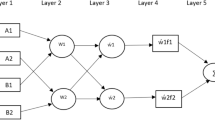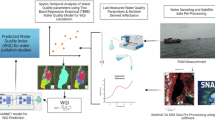Abstract
Monitoring and managing lake water quality are some of the most reminiscent of aquatic environmental challenges. Prediction of water quality parameters plays a major role in the enrichment of water resource management. This study creates and compares deep learning models such as ANFIS (adaptive neuro-fuzzy inference system), LSTM (long short-term memory), and NAR neural networks in water quality prediction and proposes the most effective prediction model. Obtaining adequate water quality data with high precision to train and test deep learning models is sometimes challenging due to cost or technological constraints. A solution to this problem was established by develo** the best band regression empirical water quality (BREWQ) model, which was used to extract seasonal water quality dataset (n = 490) from multi-resolution satellite imagery (Sentinel 2A) for 2016–2021. The accuracy assessment parameters, such as coefficient of determination (R2), mean squared error (MSE), root mean squared error (RMSE), and mean absolute percentage error (MAPE), is confined to illustrate the performance accuracy of the incorporated models. The results from this study inferred that the ANFIS model approach of Gbellmf linear, Gaussmff with the fuzzy set combination of [3 3 3 3] has the potential to predict magnesium-87.03% (MSE:8.2436, RMSE:9.92, MAPE:4.50), potassium-94.34% (MSE:6.24, RMSE: 8.06, MAPE: 31.55), sodium-96.19% (MSE:5.82, RMSE:7.36, MAPE:4.82). Secchi Disc Depth (SDD)-99.87% (MSE:3.72, RMSE:6.14, MAPE:16.03), temperature-96.2% (MSE:2.19, RMSE:3.67, MAPE:45.33), total hardness-90.31% (MSE:8.09, RMSE:10.13, MAPE: 8.91) and turbidity-60.52% (MSE:6.24, RMSE: 8.08, and MAPE:1688.43) with the least error, whereas LSTM showed the lowest error in predicting parameters such as Chlorophyll-a (Chl-a)- 96.76% (MSE:8.78, RMSE:10.4502 & MAPE:16.83), and Total Suspended Solids (TSS)-84.31% (MSE:3.58, RMSE: 6.68, MAPE:35.69). On the other hand, it is revealed from this study that NARNET had less accuracy than LSTM and ANFIS in predicting water quality due to their simple network structure. In the ultramodern era, such deep-learning prediction models aid in continuously monitoring water bodies to prevent pollution.































Similar content being viewed by others
Data Availability
The datasets generated and analysed during the current study are available from the corresponding author upon reasonable request.
References
Ahn Y, Shanmugam P, Lee J, Kang Y (2006) Application of satellite infrared data for map** of thermal plume contamination in coastal ecosystem of Korea. Mar Environ Res 61(2):186–201. https://doi.org/10.1016/j.marenvres.2005.09.001
Aldhyani THH, Al-Yaari M, Alkahtani H, Maashi M (2020) Water quality prediction using artificial intelligence algorithms. Applied Bionics and Biomechanics 2020:1–12. https://doi.org/10.1155/2020/6659314
Allan MG, Hicks BJ, Brabyn L (2007) Remote Sensing of Water Quality in the Rotorua Lakes. The University of Waikato: Hamilton, New Zealand, CBER Contract Report 51. https://hdl.handle.net/10289/3785.
Allee R, Johnson J (1999) Use of satellite imagery to estimate surface chlorophyll a and secchi disc depth of bull shoals reservoir, Arkansas, USA. Int J Remote Sens 20:1057–1072. https://doi.org/10.1080/014311699212849
Almusawi AR, Dulger LC, Kapucu S (2019) Artificial Neural Network Based Kinematics: Case Study on Robotic Surgery. In: Uhl, T. (eds) Advances in Mechanism and Machine Science. IFToMM WC 2019. Mechanisms and Machine Science 73. https://doi.org/10.1007/978-3-030-20131-9_182.
Azad A, Karami H, Farzin S (2018) Prediction of water quality parameters using ANFIS optimized by intelligence algorithms (Case Study: Gorganrood River). KSCE J Civ Eng 22:2206–2213. https://doi.org/10.1007/s12205-017-1703-6
Azad A, Karami H, Farzin, Sayed-Farhad Mousavi S, Kisi O (2019) Modeling river water quality parameters using modified adaptive neuro fuzzy inference system. Water Science and Engineering 12(1): 45–54. ISSN 1674–2370, https://doi.org/10.1016/j.wse.2018.11.001.
Fu B, Lao Z, Liang Y, Sun J, He X, Deng T, He W, Fan D, Gao E, Hou Q (2022) Evaluating optically and non-optically active water quality and its response relationship to hydro-meteorology using multi-source data in Poyang Lake, China. Ecological Indicators 145: 109675. https://doi.org/10.1016/j.ecolind.2022.109675.
Bora M, Goswami DC (2017) Water quality assessment in terms of water quality index (WQI): case study of the Kolong River, Assam, India. Appl Water Sci 7:3125–3135. https://doi.org/10.1007/s13201-016-0451-y
Cao Q, Yu G, Qiao Z (2023) Application and recent progress of inland water monitoring using remote sensing techniques. Environ Monit Assess 195:125. https://doi.org/10.1007/s10661-022-10690-9
Chen WB, Liu WC (2014) Artificial neural network modeling of dissolved oxygen in reservoir. Environ Monit Assess 186:1203–1217. https://doi.org/10.1007/s10661-013-3450-6
Chen Y, Song L, Liu Y, Yang L, Li D (2020) A review of the artificial neural network models for water quality prediction. Appl Sci 10(17):5776. https://doi.org/10.3390/app10175776
Couto C, Vicente H, Machado J, Abelha A, Neves J (2012) Water quality modeling using artificial intelligence-based tools. Int J Design Nat Ecodyn 7(9):300–309. https://doi.org/10.2495/DNE-V7-N3-300-309
Diamantopoulou MJ, Papamichail DM, Antonopoulos VZ (2005) The use of a Neural Network technique for the prediction of water quality parameters. Oper Res Int J 5:115–125. https://doi.org/10.1007/BF02944165
Guettaf M, Maoui A, Ihdene Z (2017) Assessment of water quality: a case study of the Seybouse River (North East of Algeria). Appl Water Sci 7:295–307. https://doi.org/10.1007/s13201-014-0245-z
Gupta R, Singh AN, Singhal A (2019) Application of ANN for Water Quality Index. International J Mach Learn Comput 9(5): 688–693. https://doi.org/10.18178/ijmlc.2019.9.5.859.
He W, Chen S, Liu X, Chen J (2008) Water quality monitoring in a slightly-polluted inland water body through remote sensing—case study of the Guanting Reservoir in Bei**g. China Front Environ Sci Eng China 2:163–171. https://doi.org/10.1007/s11783-008-0027-7
Hoogenboom H, Dekker A, Althuis IA (1998) Simulation of AVIRIS sensitivity for detecting chlorophyll over coastal and inland waters. Remote Sens Environ 65:333–340. https://doi.org/10.1016/S0034-4257(98)00042-X
Isiyaka HA, Mustapha A, Juahir H et al (2019) Water quality modeling using artificial neural network and multivariate statistical techniques. Model Earth Syst Environ 5:583–593. https://doi.org/10.1007/s40808-018-0551-9
Karayiannis NB, Venetsanopoulos AN (1993) Applications of Neural Networks: A Case Study. In: Artificial Neural Networks. The Springer International Series in Engineering and Computer Science 209. Springer, Boston, MA. https://doi.org/10.1007/978-1-4757-4547-4_8.
Kumar R, Parvaze S, Huda MB (2022) The changing water quality of lakes—a case study of Dal Lake, Kashmir Valley. Environ Monit Assess 194 (228). https://doi.org/10.1007/s10661-022-09869-x.
Lim J, Choi M (2015) Assessment of water quality based on Landsat 8 operational land imager associated with human activities in Korea. Environ Monit Assess 187(384):1–17. https://doi.org/10.1007/s10661-015-4616-1
Liu P, Wang J, Sangaiah AK, **e Y, Yin X (2019) Analysis and prediction of water quality using LSTM deep neural networks in IoT environment. Sustainability 11:2058. https://doi.org/10.3390/su11072058
Mahdy A, Hilt S, Filiz N, Beklioglu M, et al (2015) Effects of water temperature on summer periphyton biomass in shallow lakes: a pan-European mesocosm experiment. Aquat Sci 77:499–510. https://doi.org/10.1007/s00027-015-0394-7
Maliki AAA, Chabuk A, Sultan MA (2020) Estimation of total dissolved solids in water bodies by spectral indices case study: Shatt al-Arab River. Water Air Soil Pollution 231:482. https://doi.org/10.1007/s11270-020-04844-z
Masoodi S, Saleem LJ, Majeed S, Wani AR, Furqan M, Banday RJ (2022) Water Pollution: “Dal Lake a Case Study”. In: Kanwar, V.S., Sharma, S.K., Prakasam, C. (eds) Proceedings of International Conference on Innovative Technologies for Clean and Sustainable Development (ICITCSD—2021). https://doi.org/10.1007/978-3-030-93936-6_54.
Mathur N, Glesk I, Buis A (2016) Comparison of adaptive neuro-fuzzy inference system (ANFIS) and Gaussian processes for machine learning (GPML) algorithms for the prediction of skin temperature in lower limb prostheses. Med Eng Phys 38(10):1083–1089. https://doi.org/10.1016/j.medengphy.2016.07.003
Meenakshi P, and Ambiga K (2022) Prediction of the water quality index using ANFIS modeling. J Pharmaceutical Negative Results 13(3): 1289–1298. https://doi.org/10.47750/pnr.2022.13.S03.202.
Murugan P, Sivakumar R, Pandiyan R (2016) Comparison of in-situ hyperspectral and landsat ETM+ data for chlorophyll-a map** in case-II water (Krishnarajapuram Lake, Bangalore). J Indian Soc Remote Sens 44:949–957. https://doi.org/10.1007/s12524-015-0531-8
Novo E, Hansom J, Curran P (1989) The effect of viewing geometry and wavelength on the relationship between reflectance and suspended sediment concentration. Int J Remote Sens 10:1357–1372. https://doi.org/10.1080/01431168908903973
Onyena AP, Nkwoji JA, Chukwu LO et al (2022) Modeling contamination on various stations along the Chanomi Creek (Niger Delta), produced by combined effects, using mathematical tools (SIMUS and WQI, methods). Model Earth Syst Environ 8:5353–5363. https://doi.org/10.1007/s40808-022-01386-7
Ramu C, Sunkara SL, Ramu R (2021) An ANN-based identification of geological features using multi-attributes: a case study from Krishna-Godavari basin. India Arab J Geosci 14:299. https://doi.org/10.1007/s12517-021-06652-z
Recknagel F, Welk A, Kim B, Takamura N (2006) Artificial Neural Network Approach to Unravel and Forecast Algal Population Dynamics of Two Lakes Different in Morphometry and Eutrophication. In: Recknagel, F. (eds) Ecological Informatics. Springer, Berlin, Heidelberg. https://doi.org/10.1007/3-540-28426-5_16.
Şahin M, Erol R (2017) A comparative study of neural networks and ANFIS for forecasting attendance rate of soccer games. Mathematical and Computational Applications 22(4):43. https://doi.org/10.3390/mca22040043
Seleem T, Bafi D, Karantzia M et al (2022) Water Quality Monitoring Using Landsat 8 and Sentinel-2 Satellite Data (2014–2020) in Timsah Lake, Ismailia, Suez Canal Region (Egypt). J Indian Soc Remote Sens 50:2411–2428. https://doi.org/10.1007/s12524-022-01613-9
Sheeba S, Dipak RS, Harish CP, Munish KC, Shirish Gedam, Rakesh Kumar, Virendra Sethi, Amar R. Supate, Subhankar Karmakar (2022) River pollution monitoring over an industrial catchment in urban ecosystem: Challenges and proposed geospatial framework. Environmental Challenges, 7. https://doi.org/10.1016/j.envc.2022.100496.
Sonic Patritia A, Martin P (2017) Phytoplankton diversity and physico- chemical parameters in Kolavai Lake, Tamil Nadu. India World J Pharmaceutical Res 6(10):1745–1755
Sun X, Zhang Y, Shi K, Zhang Y, Li N, Wang W, Huang X, Qin B (2022) Monitoring water quality using proximal remote sensing technology. Sci Total Environ, 803: 149805. https://doi.org/10.1016/j.scitotenv.2021.149805.
Sundarambal P, Liong S-Y, Tkalich P (2008) An ANN application for water quality forecasting. Mar Pollut Bull 56(9):1586–1597. https://doi.org/10.1016/j.marpolbul.2008.05.021
Thekkuden DT, Mourad AHI (2019) Investigation of feed-forward back propagation ANN using voltage signals for the early prediction of the welding defect. SN Appl Sci 1:1615. https://doi.org/10.1007/s42452-019-1660-4
Thirumarran M, Esakku S, Chandrasekaran A (2017) Assessment of ground water quality around adayar river, Chennai, Tamil Nadu, India. Int J Eng Res Technol (IJERT), 6(3). https://doi.org/10.17577/IJERTV6IS030331.
Tian S, Guo H, Xu W et al (2022) Remote sensing retrieval of inland water quality parameters using Sentinel-2 and multiple machine learning algorithms. Environ Sci Pollut Res. https://doi.org/10.1007/s11356-022-23431-9
Valadkhan D, Moghaddasi R, Mohammadinejad A (2022) Groundwater quality prediction based on LSTM RNN: an Iranian experience. Int J Environ Sci Technol 19:11397–11408. https://doi.org/10.1007/s13762-022-04356-9
Van Houdt G, Mosquera C, Nápoles G (2020) A review on the long short-term memory model. Artif Intell Rev 53:5929–5955. https://doi.org/10.1007/s10462-020-09838-1
Venkata Vara Prasad D, Lokeswari Y, Venkataramana P, Senthil Kumar G, Prasannamedha S, Harshana S, Jahnavi Srividya K, Harrinei, Sravya Indraganti (2022) Analysis and prediction of water quality using deep learning and auto deep learning techniques, Sci Total Environ 821. https://doi.org/10.1016/j.scitotenv.2022.153311.
Wang W, Shi K, Zhang Y, Li N, Sun X, Zhang D, Zhang Y, Qin B, Zhu G (2022) A ground-based remote sensing system for high-frequency and real-time monitoring of phytoplankton blooms, J Hazardous Materials 439: 129623. https://doi.org/10.1016/j.jhazmat.2022.129623.
Sulaiman K, Ismail LH, Mohammad Razi MA, Adnan MS, Ghazali R (2019) Water quality classification using an artificial neural network (ANN), IOP Conf. Ser.: Mater. Sci. Eng. 601(1).
Xu H, Paerl HW, Qin B, Zhu G, Hall N, Wu Y (2014) Determining critical nutrient thresholds needed to control harmful cyanobacterial blooms in eutrophic Lake Taihu, China. Environ Sci Technol 49:1051–1059. https://doi.org/10.1021/es503744q
Xu L, Huang C. Li Y. **a C (2013) Deriving Concentration of TN, TP based on Hyper Spectral Reflectivity. Remote. Sens. Technol. Appl 28: 681–688. http://www.rsta.ac.cn/EN/Y2013/V28/I4/681.
Acknowledgements
Big Data Analytics/ Hyperspectral Remote Sensing, ICPS Division, Department of Science and Technology, Government of India (Reference Number: BDID/01/23/2014-HSRS/14) generously supported this research. We thank the SRM Institute of Science and Technology for providing all research facilities and continuous encouragement.
Author information
Authors and Affiliations
Corresponding author
Ethics declarations
Conflict of interest
There are no conflicts of interest to declare.
Additional information
Publisher's Note
Springer Nature remains neutral with regard to jurisdictional claims in published maps and institutional affiliations.
Rights and permissions
Springer Nature or its licensor (e.g. a society or other partner) holds exclusive rights to this article under a publishing agreement with the author(s) or other rightsholder(s); author self-archiving of the accepted manuscript version of this article is solely governed by the terms of such publishing agreement and applicable law.
About this article
Cite this article
Ramaraj, M., Sivakumar, R. Integration of band regression empirical water quality (BREWQ) model with deep learning algorithm in spatiotemporal modeling and prediction of surface water quality parameters. Model. Earth Syst. Environ. 9, 3279–3304 (2023). https://doi.org/10.1007/s40808-023-01695-5
Received:
Accepted:
Published:
Issue Date:
DOI: https://doi.org/10.1007/s40808-023-01695-5




